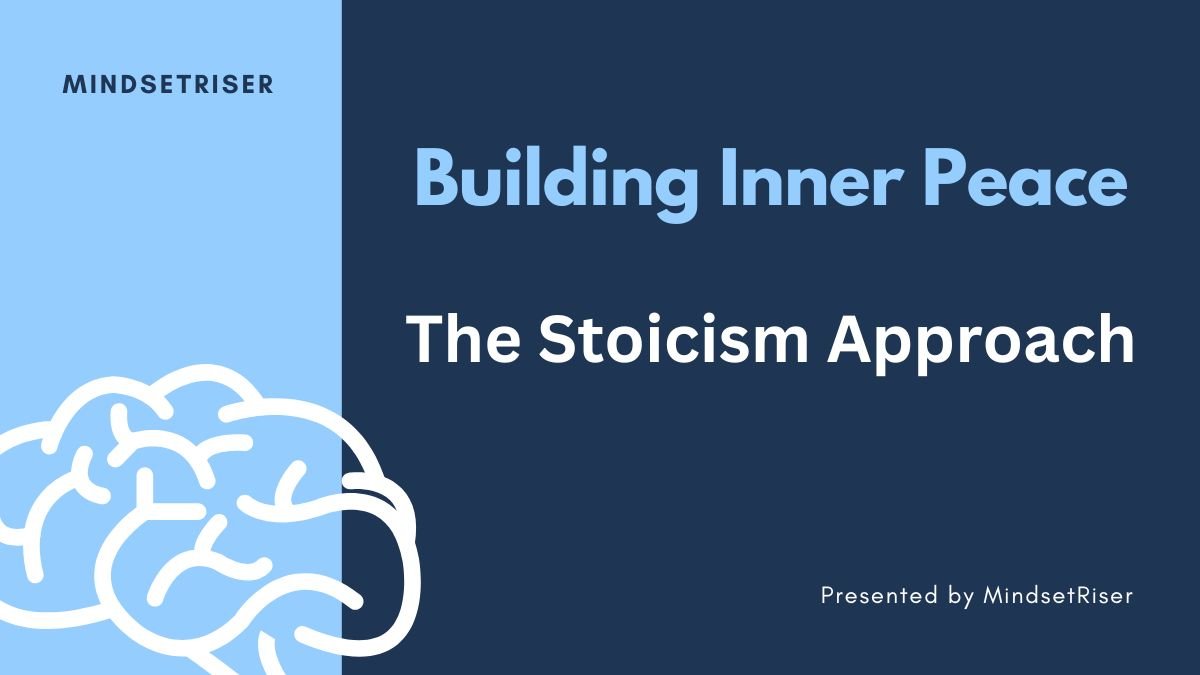Building Inner Peace: Exploring the Philosophy of Stoicism
achieving inner peace can feel like an elusive goal. However, the ancient philosophy of Stoicism offers practical tools to help individuals find tranquility amidst life’s challenges. Stoicism, which originated in ancient Greece and was later developed by Roman thinkers, emphasizes resilience, rationality, and the pursuit of virtue. By following its principles, you can cultivate inner peace, reduce stress, and live a more fulfilling life.
1. What is Stoicism?
Stoicism is a school of philosophy founded by Zeno of Citium around 300 BCE. It teaches that happiness and inner peace come from focusing on what is within our control and accepting what we cannot change. Stoics believe that our thoughts, emotions, and actions are the only things we can truly control, and everything else—such as external events or other people’s behavior—lies beyond our influence.
- Key Idea: The core of Stoicism lies in recognizing the distinction between what we can and cannot control. Stoics advocate focusing on our responses to external events rather than attempting to control the world around us. This mindset enables us to maintain peace in the face of adversity.
Reflection: Embracing the Stoic view that we can control only our reactions helps us take ownership of our mental state and fosters a sense of calm, no matter the external circumstances.
2. The Dichotomy of Control: A Key Stoic Principle
One of the most essential teachings of Stoicism is the “Dichotomy of Control.” This principle divides all experiences into two categories: things we can control (our thoughts, emotions, and actions) and things we cannot control (external events, other people’s actions, and outcomes).
- Key Idea: By focusing only on what is within our control, we free ourselves from the stress and frustration that arise when we try to control the uncontrollable. The Stoic philosopher Epictetus famously said, “It’s not what happens to you, but how you react to it that matters.”
- Practical Application: Whenever you feel stressed or overwhelmed, ask yourself: Is this something I can control? If yes, take action. If no, let it go. This mindset reduces anxiety and helps you maintain composure in difficult situations.
Reflection: By adopting the Dichotomy of Control, you regain power over your emotional state and eliminate unnecessary worry about external factors that you cannot influence.
3. Living in Accordance with Nature
For Stoics, living in harmony with nature is central to achieving inner peace. This doesn’t mean simply enjoying the natural world but understanding and accepting the natural order of things. Everything in life, including challenges and hardships, is part of the larger, natural flow of existence.
- Key Idea: Stoics believe that by aligning our actions with the natural world, we can live more authentically and with greater peace of mind. This involves accepting that life is unpredictable and that suffering is a natural part of the human experience.
- Practical Application: Instead of resisting challenges or trying to avoid discomfort, Stoics encourage embracing life’s uncertainties with calm acceptance. Accepting both pleasure and pain as part of the human condition allows us to cultivate a sense of inner peace and resilience.
Reflection: When you stop resisting the flow of life and accept each moment as it is, you reduce the mental turmoil that often arises from trying to control the uncontrollable.
4. Practicing Virtue: The Path to True Peace
Virtue, for Stoics, is the highest good. Stoics believe that living virtuously—by practicing wisdom, courage, justice, and moderation—leads to a harmonious and peaceful life. By making virtuous choices in everyday life, individuals align themselves with their true nature and find fulfillment.
- Key Idea: Virtue is not just about moral excellence but about living in accordance with reason. Stoics see reason as the guiding force of human nature, and by making decisions based on rational thought, we move closer to achieving inner peace.
- Practical Application: In your daily life, aim to cultivate virtues like patience, humility, and self-discipline. For example, when faced with an emotional reaction, pause and reflect before responding. This allows you to act thoughtfully, based on your rational mind, rather than being driven by impulses.
Reflection: The pursuit of virtue offers a sense of purpose and satisfaction that external achievements or possessions cannot provide. Virtuous living fosters peace by aligning your actions with your core values.
5. The Practice of Negative Visualization
Negative visualization is a Stoic exercise that involves imagining the worst-case scenario to help reduce fear and anxiety about the future. By mentally preparing for potential setbacks or losses, you can learn to appreciate what you have and develop resilience.
- Key Idea: Stoics do not dwell on negativity but use this practice to prepare themselves emotionally for any outcome. By envisioning loss or failure, they can develop gratitude for what they have and become more accepting of life’s inevitable challenges.
- Practical Application: Set aside time each day to reflect on the possibility of loss, whether it’s losing a job, a relationship, or your health. Instead of fearing these possibilities, accept them as part of life. This practice will help you build resilience and appreciate the present moment.
Reflection: Negative visualization isn’t meant to foster pessimism but to cultivate gratitude and acceptance. It shifts your focus from fear to appreciation, allowing you to handle life’s challenges with greater equanimity.
6. The Role of Mindfulness and Self-Reflection
While Stoicism emphasizes rational thinking, it also places significant value on mindfulness and self-reflection. By regularly reflecting on our thoughts, actions, and emotions, we gain clarity on what truly matters and how to live in alignment with our values.
- Key Idea: Regular self-reflection helps you become aware of your reactions, habits, and beliefs. Stoics recommend taking time each day to examine your behavior and evaluate whether it aligns with your virtues.
- Practical Application: At the end of each day, take a few moments to reflect on your actions. Consider whether you responded with patience, kindness, and wisdom. This self-awareness enables you to grow and improve over time, fostering inner peace.
Reflection: Mindfulness and self-reflection are essential tools for staying grounded and aware of your emotional state. They help you maintain a calm and clear mind, enabling you to navigate life’s challenges with peace and wisdom.
7. Modern Stoicism: A Practical Approach to Inner Peace
In recent years, Stoicism has experienced a revival as many people seek practical wisdom to navigate the complexities of modern life. Stoicism’s emphasis on resilience, rationality, and virtue resonates deeply with individuals facing stress, uncertainty, and rapid change.
- Key Idea: Modern Stoicism adapts the principles of ancient Stoic philosophy to contemporary challenges. Whether you’re dealing with work-related stress, personal relationships, or societal pressures, Stoic practices can help you maintain your inner peace.
- Practical Application: Apply Stoic techniques such as mindfulness, reframing negative thoughts, and focusing on what you can control. You can also turn to Stoic writings, such as Marcus Aurelius’ Meditations, to gain insight into how ancient Stoics handled adversity.
Reflection: Modern Stoicism provides a timeless blueprint for inner peace, offering practical tools to navigate life with clarity and resilience. By incorporating these practices into your daily life, you can cultivate lasting peace in an ever-changing world.
Conclusion: Stoicism as a Path to Lasting Inner Peace
The philosophy of Stoicism offers powerful strategies for building inner peace. By embracing the principles of the Dichotomy of Control, living in accordance with nature, practicing virtue, and engaging in mindfulness, you can navigate life’s challenges with calm and clarity. Stoicism teaches that true peace comes not from external circumstances but from mastering our internal world.
By integrating Stoic practices into your daily life, you can foster resilience, reduce stress, and live in harmony with your values. Stoicism empowers you to take control of your thoughts, actions, and emotions, creating a foundation for lasting inner peace.

